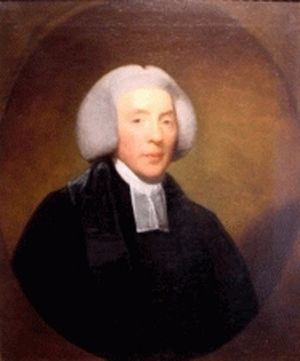Hugh Hamilton (bishop) facts for kids
Quick facts for kids
Hugh Hamilton
|
|
|---|---|

Portrait by Gilbert Stuart, c. 1790
|
|
| Born | 26 March 1729 Knock, County Dublin, Ireland
|
| Died | 1 December 1805 (aged 76) Kilkenny, County Kilkenny, Ireland
|
| Known for | Professor of natural philosophy, Anglican bishop |
Hugh Hamilton FRS (26 March 1729 – 1 December 1805) was a very smart person who lived a long time ago. He was a mathematician, which means he studied numbers and shapes. He was also a natural philosopher, which was like being a scientist back then.
He taught at Trinity College Dublin, a famous university in Ireland. Later in his life, he became a bishop in the Church of Ireland, which is a religious leader. He was the Bishop of Clonfert and Kilmacduagh, and then the Bishop of Ossory.
Contents
Hugh Hamilton's Early Life and Education
Hugh Hamilton was born on March 26, 1729, in a place called Knock, near Balrothery in County Dublin, Ireland. He was the oldest son of Alexander and Isabella Hamilton. His father was a lawyer and also a politician.
When Hugh was only 13 years old, he started studying at Trinity College Dublin. This was on November 17, 1742. He worked very hard and earned his first degree, a Bachelor of Arts (BA), in 1747. A few years later, in 1750, he got his Master of Arts (MA Dubl) degree.
In 1751, when he was 22, Hugh became a Fellow of Trinity College. This was a special honor that meant he could teach and do research there.
Becoming a Professor and Bishop
Hugh Hamilton became a professor in 1759. He was named the Erasmus Smith's Professor of Natural and Experimental Philosophy at Trinity College Dublin. This meant he taught science and how things work in nature. In the same year, he also earned a Bachelor of Divinity (BD) degree.
He was recognized for his smarts by important groups. On February 19, 1761, he was chosen as a Fellow of the Royal Society. This is a very old and respected group of scientists in the United Kingdom. In 1762, he earned his Doctor of Divinity (DD) degree.
In 1764, Hugh left his teaching job at Trinity College for a while. He became a rector, which is a type of church leader, in a place called Kilmacrenan in County Donegal. He later became the vicar of St. Anne's in Dublin in 1767.
Life as Dean of Armagh
From 1768 to 1796, Hugh Hamilton was the Dean of Armagh. This meant he was the main church leader at St Patrick's Cathedral in Armagh. He did many good things for the community there.
He helped build a new house for the dean, which is now known as Dean's Hill. He also started Sunday schools to help children learn. He set up a special loan fund to help poor tradesmen, which are people who work with their hands. He even helped plan a way to bring piped water to the town.
In 1785, Hugh Hamilton was one of the first 38 members of the Royal Irish Academy. This is another important group that studies science, literature, and antiquities in Ireland. A famous artist named Gilbert Stuart painted his picture around 1790.
Later Years as Bishop
Hugh Hamilton became a bishop in 1796. He was made the Bishop of Clonfert and Kilmacduagh. Then, in 1799, he became the Bishop of Ossory. He served as bishop until he passed away.
He died from a fever in Kilkenny on December 1, 1805. He was buried in the graveyard of St Canice's Cathedral in Kilkenny. There is a special memorial inside the cathedral to remember him.
Hugh Hamilton's Important Works
Hugh Hamilton wrote several important books and essays. One of his most famous works was a math book called De Sectionibus Conicis: Tractatus Geometricus. It was published in 1758.
In this book, he explained how different shapes called conic sections are formed from a cone. People praised his book for being very clear and easy to understand. A famous mathematician named Leonhard Euler even called it a "perfect book." It was used in many universities in Britain and was translated into English in 1773.
He also wrote other books, including:
- Philosophical Essays on Vapours (1767)
- Four Introductory Lectures on Natural Philosophy (1774)
- An Essay on the Existence and Attributes of the Supreme Being (1784)
After he died, his oldest son, Alexander Hamilton, collected all his main works and published them in two volumes in 1809.
Hugh Hamilton's Family
In 1772, Hugh Hamilton married Isabella Wood. They had five sons and two daughters together.
One of their sons, Hans, became a rector, which is a church leader. Another son, George, became a scholar who studied the Bible.
A very interesting family connection is through his son Hugh. This younger Hugh married Elizabeth Staples. Their great-grandson was C. S. Lewis, who wrote the famous Chronicles of Narnia books! So, Bishop Hugh Hamilton was C. S. Lewis's great-great-great-grandfather.
Hugh Hamilton also had other notable descendants, including the mathematicians John Lighton Synge and his brother Edward Hutchinson Synge.

